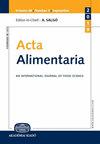Optimisation of ultrasound-assisted extraction of carotenoids and antioxidant activity from Citrus reticulata Blanco peels (Wilking mandarin)
IF 1
4区 农林科学
Q4 FOOD SCIENCE & TECHNOLOGY
引用次数: 0
Abstract
A large amount of waste, especially the outer part of citrus fruits (peel), is generated after consuming the pulp and it remains unused. The valorisation of this waste by recovering its bioactive compounds seems interesting. The aim of this study was to find the optimal conditions using ultrasound-assisted extraction (UAE) that yield the highest carotenoid content and better antioxidant activity from Citrus reticulata Blanco peels.Response surface methodology (RSM) through Box–Behnken experimental design was used to optimise the conditions for carotenoid extraction using UAE. Hexane concentration, temperature, and sonication time were selected as the main factors.The results revealed that all independent variables affected the responses. The optimal UAE conditions for hexane concentration, temperature, and sonication time were 60.76%, 36.45 °C, and 37.32 min, respectively. The values of total carotenoid content (TCC) and total antioxidant activity (TAA) obtained by UAE were higher than those obtained by the maceration extraction method.It can be concluded that the medium and extraction parameters, including hexane concentration, temperature, and sonication time, significantly influenced the recovery of carotenoids and antioxidant activity. The optimisation study allowed determining the appropriate conditions to maximise both responses. Compared to conventional maceration, the UAE method was superior and more efficient for extracting carotenoids from C. reticulata Blanco peels.超声辅助提取柑橘皮类胡萝卜素及抗氧化活性的优化
大量的废物,尤其是柑橘类水果的外层(果皮),在食用果肉后会产生,而果肉一直未被利用。通过回收这些废物的生物活性化合物来使其增值似乎很有趣。本研究旨在探讨超声辅助提取柑橘果皮中类胡萝卜素含量和抗氧化活性最高的最佳工艺条件。采用Box-Behnken试验设计的响应面法(RSM)优化了UAE提取类胡萝卜素的工艺条件。选取了正己烷浓度、温度和超声时间作为主要影响因素。结果显示,所有的自变量都影响了回答。正己烷浓度为60.76%,超声温度为36.45℃,超声时间为37.32 min。黄芪总类胡萝卜素含量(TCC)和总抗氧化活性(TAA)均高于浸渍法。综上所述,介质和提取参数(己烷浓度、温度、超声时间)对类胡萝卜素的回收率和抗氧化活性有显著影响。优化研究允许确定适当的条件,以最大限度地提高两种反应。与传统浸渍法相比,UAE法对黄皮类胡萝卜素的提取效率更高。
本文章由计算机程序翻译,如有差异,请以英文原文为准。
求助全文
约1分钟内获得全文
求助全文
来源期刊

Acta Alimentaria
农林科学-食品科技
CiteScore
1.80
自引率
0.00%
发文量
47
审稿时长
18-36 weeks
期刊介绍:
Acta Alimentaria publishes original papers and reviews on food science (physics, physical chemistry, chemistry, analysis, biology, microbiology, enzymology, engineering, instrumentation, automation and economics of foods, food production and food technology, food quality, post-harvest treatments, food safety and nutrition).
 求助内容:
求助内容: 应助结果提醒方式:
应助结果提醒方式:


